While I’m a big fan of digital detoxing, there are plenty of good reasons to bring a portable solar panel camping, like charging your phone, emergency communication devices, GPS, headlamp batteries, photo equipment…
Not all portable solar panels are suited for camping though. The ones reviewed here are all compact enough to be carried, can withstand the abuses of camping, and provide enough power to reliably (focus on reliable!) power the devices you likely use at camp.
Based on my experience and of friends and tons of research, here are the best portable solar panels for camping plus everything you need to know about choosing solar panels for outdoor activities.
Top Picks
- Best Overall: Goal Zero Nomad
- Best Value: Renogy E. Flex 50W
- Best for Backpacking: Anker 21W PowerPort
- Best for Compact Size: TP-Solar 60W
Comparison
*Note that most of these portable solar panels are also available in other sizes.
| Product | Weight | Folded Size | Outlets | Chainable |
|---|---|---|---|---|
| Goal Zero Nomad 50 | 6.85lbs | 17x11.25" | USB-A 8mm | Yes |
| Jackery SolarSaga 60W | 3.3lbs | 16.8x11.4" | USB-A USB-C Anderson | Yes |
| Renogy E. Flex 50W | 5.25lbs | 19.9x16.1" | USB-A USB-C Switchable DC | Yes |
| Anker 21W PowerPort | 0.8lbs | 11x6.3" | USB 3.0 | No |
| Goal Zero Boulder 50W | 12.4lbs | 21.75x26.75" | 8mm | Yes |
| RockPals 60W | 5.6lbs | 13.8x13.4" | 3xUSB 3.0 5.5 x 2.1mm DC | No |
| TogoPower 60W | 6.5lbs | 16x14" | USB-A USB-C DC | No |
| TP-Solar 60W | 3.1lbs | 9.8x7.8" | Dual USB-A DC | No |
Best Portable Camping Solar Panels
1. Goal Zero Nomad Solar Panels
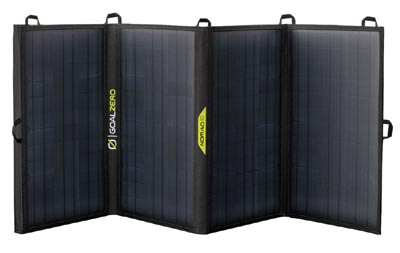
Choose If: You don’t mind paying more for a reliable brand
Specs (for 50w solar panel):
- Panel Type: Monocrystalline
- Weight: 6.85lbs
- Folded Size: 17 x 11.25 x 2.5 inches
- Open Size: 53 x 17 x 1.5 inches
- Outlets: USB-A (5V, 2.4amp) and 8mm (14-22V, 3.5A)
- Chainable: Yes – including different sizes
- Available At: Amazon, REI
Review:
Goal Zero is the best-known brand of solar panels for camping. Their products are meant for outdoor use and designed to be rugged. They also are incredibly high quality and very efficient monocrystalline panels.
The Nomad series of Goal Zero solar panels are their most portable. The smallest one is 5 watts and the largest is 200 watts. For camping, you’ll probably want the 20, 50 or 100 watt versions, depending on how many devices you are bringing along.
A nice feature is that the Nomad panels have a USB outlet for direct charging devices at 5V and up to 2.4A. This is much faster than the 1amp charge most portable solar chargers offer.
There is also an 8mm outlet for charging a battery. It’s compatible with the Goal Zero power stations, which are also rugged and have an impressive list of features – particularly the built-in charger controller and inverter so you don’t have to carry multiple components with you.
Pros:
- Very reliable brand
- High-quality panels
- Rugged build
- Lightweight and compact for its class
- Mostly waterproof
- Can chain them with other Goal Zero panels
Cons:
- Pricier than lesser-known brands
- Stupidly popular; the 50W panels are often out of stock
- No USB-C outlet
2. Jackery SolarSaga
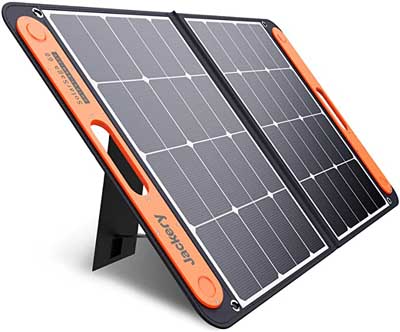
Choose If: You want a reliable and sturdy solar panel but don’t want to pay Goal Zero prices.
Specs (for 60w solar panel):
- Panel Type: Monocrystalline
- Weight: 3.3lbs
- Folded Size: 16.8 x 11.4 x 0.2 inches
- Open Size: 35.2 x 16.8 x 0.2 inches
- Outlets: USB-A (5V, 2.4amp), USB-C (5V, 3amp) and Anderson Connector (DC 18V, 3.3amp)
- Chainable: Up to 2 panels
- Available At: Amazon
Review:
Jackery released the SolarSaga in 2020 to compete with the Goal Zero Nomad panels. They are available in 60 and 100 watt sizes.
Like the Nomad, the SolarSaga series are designed to be portable. They have a really nice folding design with a built-in rubberized orange handle. It looks sleek and professional and the hinges between the panels feels sturdy.
There are two USB outlets so you can directly charge devices simultaneously. There is also an Anderson connection. Jackery includes an Anderson-to-8mm cable to be used with the Jackery power station. However, note that their 8mm cable isn’t the same as the Goal Zero cable; it doesn’t fit well in the Yeti power station. If you want to charge a Yeti with the SolarSaga, then you’ll need to get Goal Zero’s adapter cable.
Compared to the Goal Zero Nomad solar panels, Jackery’s SolarSaga panels are much lighter and thinner. They are half the weight and a fraction of the thickness (2.5 inches compared to 0.2 inches!). There is also a built-in kickstand which can be adjusted to preset angles.
While the ultralight design is appealing for portability (even backpackers could carry this on trips), it does mean the SolarSaga panels aren’t as durable or tough. They aren’t waterproof and you won’t want to leave them unattended; even a slight breeze could send them toppling over.
Pros:
- Very lightweight and compact
- Two USB outlets
- Built-in adjustable kickstand
- Rubberized carrying cable
- Comes with adapters
Cons:
- Not waterproof
- Easily toppled by wind
- Not compatible with all power stations
Check Price at Amazon
3. Renogy E. Flex Solar Panels
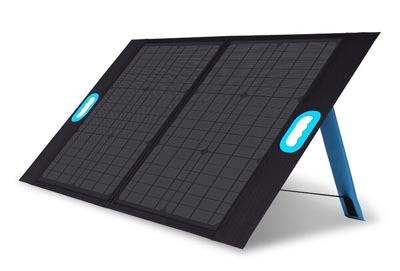
Choose If: You want a really good value
Specs (for 50W panel):
- Panel Type: Monocrystalline
- Weight: 5.25lbs
- Folded Size: 19.9 x 16.1 x 0.8 inch
- Open Size: 32.5 x 19.9 x 0.2 inch
- Outlets: USB A (5V, 2.4amp), USB-C (5V, 3amp), switchable DC (19V/2.4amp and 16V/2.8amp) and solar connector output (18V, 2.77amp)
- Chainable: Yes
- Available At: Amazon
Review:
Renogy is well known for their affordable solar panels. Most of the Renogy solar panels are not very portable. However, their E. Flex panels are the exception. In particular, their 21, 30 and 50 watt solar panels are portable and light enough to use at camp.
Despite the low price, the E. Flex solar panels still have features like auto-reset, so you don’t have to worry that the charging will stop if a cloud passes overhead. However, some users did report problems with it and had to unplug/replug devices to get them charging again. Likewise, it doesn’t do great at charging multiple devices at once because of amp drops.
Pros:
- Affordable
- Easy to use
- Good built-in features
- Built-in kickstand
Cons:
- Some issues with the auto reset feature
- Not great at charging multiple devices simultaneously
Check Price At Amazon
4. Anker 21W PowerPort Solar Panel
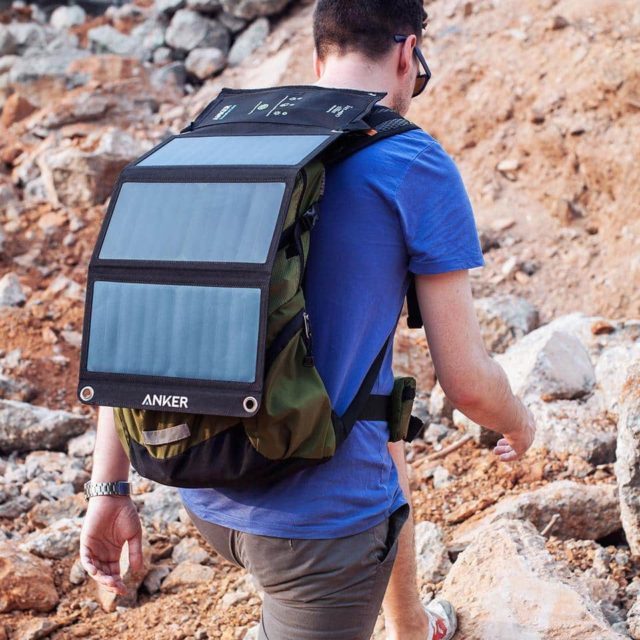
Choose If: You need a lightweight solar panel for hiking
Specs:
- Panel Type: Monocrystalline
- Weight: 13.2oz
- Folded Size: 11 x 6.3 inches
- Open Size: 18.1 x 11 inches
- Outlets: USB 3.0
- Chainable: No
- Available At: Amazon
Review:
The Anker PowerPort is my top pick for ultralight backpacking solar panels. It is just 13.2oz, which means it has 1.6 watts per ounce. Few portable solar panels come close to offering that much power per weight.
While 21W is too low for campers who bring multiple devices or appliances, it’s just right for keeping your phone, Kindle, or other small devices topped off during occasional use. You’ll probably want to use a power bank as it’s more reliable than direct charging. There are grommets so you can hang it from a tent, your car, backpack, etc. to capture sunlight.
It is designed in a way so the solar panel folds down quite compact but still delivers enough surface area for capturing sunlight. There are smart built-in features like auto-reset so you don’t have to worry about the charger stopping because of passing clouds. There’s also a blocking diode so the charge won’t drain your batteries instead of charging them in low-light situations.
The brand Anker is also highly reputable and known for producing quality power banks and other portable power solutions. If you pair this solar panel with their Anker Astro power bank (just 4.2oz and 6700mAh), you will have a very efficient, lightweight solar setup for camping or backpacking.
Pros:
- High quality solar panel
- Lightweight setup
- Very portable
- Auto reset and blocking diode
Cons:
- Only USB outlet
- Not great at trickle charging
Check Price At Amazon
5. Goal Zero Boulder Solar Panels
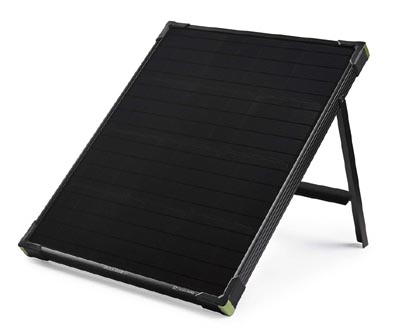
Choose If: You want an affordable and durable briefcase solar panel that can be chained
Specs (for 50w solar panel):
- Panel Type: Monocrystalline
- Weight: 12.4lbs
- Size: 21.75 x 26.75 x 1.75 inches
- Outlets: 8mm (14-22V, 3.5A)
- Chainable: Yes
- Available At: Amazon, REI
Review:
The Boulder is Goal Zero’s rigid solar panel collection. Compared to the Nomad panels, the Boulder panels are much more robust: they can really withstand a beating. They are waterproof and can even be left outside overnight. You won’t have to worry about them toppling over in a slight breeze.
You can tell just by the warranty that the Briefcase is a more durable product: it has a 2 year warranty compared to just 1 year with the Nomad solar panels.
Another nice feature of the Boulder solar panels is that they have a built-in stand. It allows you to easily adjust the angle of the solar panel so it gets maximum sunlight.
The rigid design does have its drawbacks. Even though Goal Zero obviously tried to keep them portable, the Boulder solar panels are still quite bulky and heavy. There is a suitcase carrier that you can get for the panels, but it’s still not ideal if you will need to carry your solar panel far to camp.
Note that the Goal Zero Boulder panels only have an 8mm outlet. They won’t be able to directly charge via USB. You’ll have to use them with a battery setup or power station.
Pros:
- High-quality panels
- 24 month warranty
- Built-in adjustable stand
- Waterproof
- Can chain them with other Goal Zero panels
Cons:
- Bulky and heavy
- No direct charging devices with USB
6. RockPals Portable Solar Panel
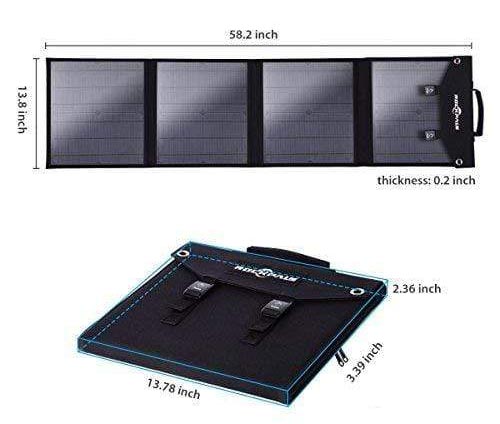
Choose If: You want to directly charge multiple devices at once
Specs (for 60W panel):
- Panel Type: Monocrystalline
- Weight: 5.6lbs
- Folded Size: 13.8 x 13.39 x 2.36 inches
- Open Size: 58.2 x 13.8 x 0.2 inches
- Outlets: 3x USB 3.0 (5V, 2.4amp each), 5.5 x 2.1mm DC (18V, 3.4amp)
- Chainable: No
- Available At: Amazon
Review:
RockPals is another brand of affordable camping solar panels. For the price, the panel is actually of a good quality and seems to withstand the abuse of camping well enough. It comes in 60W and 100W sizes. It’s designed to be compatible with the most popular power stations (like the Yeti and Jackery stations) and comes with a set of adapters for charging them.
There are three USB 3.0 outlets which allow you to charge devices simultaneously at a max of 2.4 amps each. The IC chip automatically determines the right charging speed and adjusts the amps based on the light. Not surprisingly though, it does have trouble with trickle charge. If the sunlight is low, you will only want to charge one or two devices at once.
It’s worth noting that the RockPals doesn’t withstand high temperatures as well as some other camping solar panels. It has a max operating temperature of 120F. The panel can easily reach that temperature in summer, so you’ll need to place a white cloth (or similar) underneath the panel to reduce heat absorption into the panel.
Pros:
- Compact 4-fold design
- Quality panel
- Comes with adapters
Cons:
- Overheats easily
- Not chainable
Check Price At Amazon
7. TogoPower Solar Panel
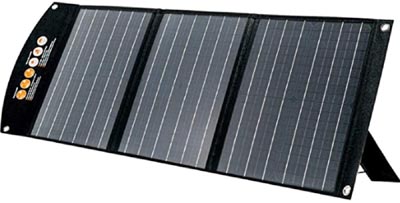
Choose If: You are on a tight budget and like the included adapters
Specs (for 60W panel):
- Panel Type: Monocrystalline
- Weight: 6.5lbs
- Folded Size: 16 x 14.6 x 2.0 inches
- Open Size: 50.7 x 16 x 1 inches
- Outlets: USB-A (0 24W) & USB-C (PD 45W) and DC (18V, 3.3amp)
- Chainable: No
- Available At: Amazon
Review:
Togo is a Chinese brand which makes cheap solar panels. I’m wary of buying from no-name Chinese brands but Togo is one which actually is of a good quality. Their monocrystalline solar panels have a high efficiency and are comparable to more expensive brands.
The TogoPower solar panels come in 60W and 120W sizes. They are a good pick for camping because of their thicker canvas backing. I also like that there is a zippered pouch for your cables and devices. This gives it some more protection against the rain. Only the front of the solar panel is water resistant though, so make sure it is brought inside in the rain.
My main complaint abou the TogoPower for camping is that it is very bulky. It only folds three times so it won’t fit in a backpack. You’ll have to carry it along your side like a briefcase. Also, the brand hasn’t been around as long as others so I can’t be certain that Togo delivers consistent quality.
Pros:
- Very affordable
- Includes adapters
- Durable materials and zippered pocket
- Two kickstands
Cons:
- Bulky even when folded
Check Price on Amazon
8. TP-Solar Panel
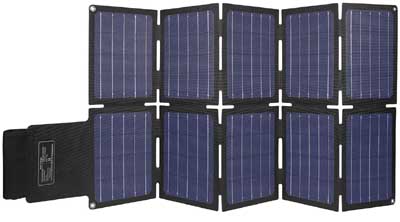
Choose If: You want a large solar panel which can fold down very compact
Specs (for 60w panel):
- Panel Type: Monocrystalline
- Weight: 1lbs
- Folded Size: 8 x 7.8 x 1.1 inches
- Open Size: 44 x 19.6 x 0.1 inches
- Outlets: Dual USB-A (5V, 2amp) and DC (19V, 5amp)
- Chainable: No
- Available At: Amazon
Review:
The TP-Solar panels come in 30W, 60W, 100W and 120W sizes. This version of the 60W solar panel is unique though because it is made of 10 separate panels that fold down into an incredibly compact package. It’s one of the few camping solar panels that can easily fit in a daypack.
Despite being cheap, the TP-Solar panels are surprisingly good quality. Side-by-side tests show that they perform as well as Goal Zero solar panels, despite costing just a fraction.
There is QC3.0 smart charging technology with the USB outlets. If your don’t have QC devices though, you won’t get the most out of these ports as you can’t choose the voltage. You might want to get a regulator for this solar panel when camping. TP-Solar claims you can use an alligator clip and cigarette lighter plug to directly charge a car battery but this isn’t recommended as you could overcharge.
Another downside is that the design means there are multiple hinges on the solar panel. Hinges are often a fail point for folding solar panels, so it might not survive extensive use.
Pros:
- Very compact design
- Lightweight
- High efficiency
- Great value
Cons:
- No USB-C outlet
- Can’t choose voltage output
- Will work best with a regulator
- Hinges are potential fail point
Check Price on Amazon
Do You Really Need a Solar Panel When Camping?
Yes, solar panels are worth it if you need power for small devices like your phone, photo equipment, or even some small appliances. However, a solar panel is only worth it if you are willing to invest in a setup which is capable of producing enough power to meet your needs. Otherwise, your solar panel will end up being an expensive, useless toy when camping.
Why do I say this? Because, while portable solar panels have come a long way, they are not perfect.
A small, cheap solar panel might be enough to top off your phone battery. But you can’t expect a small solar panel to power a refrigerator! You really need to be realistic about what solar panels can do, calculate your needs, hopefully also reduce your energy needs, and get the right setup.
How to Charge Devices with Solar while Camping
There are two main ways you can use portable solar panels when camping.
Option 1: Directly Charge Devices from the Solar Panel
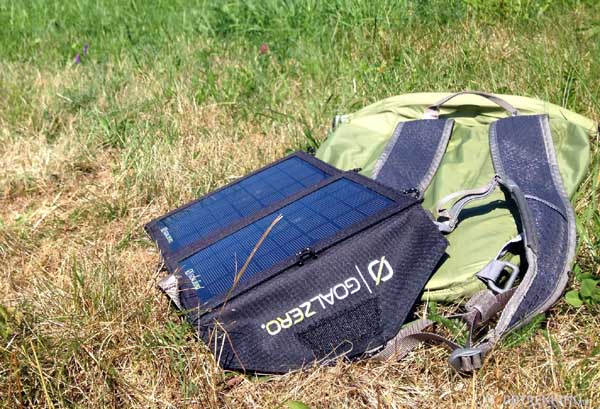
A small solar panel directly charging a phone via USB. The phone is kept out of the sun to prevent overheating.
Almost all portable solar panels have USB outlets. To use them, you simply plug your device into the solar panel, put the solar panel in the sun, and let it charge the device.
Benefits:
The main benefit of directly charging is that it is more efficient. When you use the solar panel to charge a battery and then charge a device, you lose some of the power. It’s lost through the cables, conversion, and through the battery. By directly charging your devices, you will get the most power from the solar panel. There also isn’t any issue of your device discharging back into the solar panel.
Downsides:
- No way of storing power: If you need to charge your device and it’s a cloudy day, you are out of luck.
- Charging slows or stops: A big issue with portable solar chargers is that, if sunlight reduces during charging – such as if a cloud passes overhead – the charger slows or stops completely. Most good solar chargers now have an auto-reset feature so they will start charging again once the sunlight returns – but surprisingly a lot of cheap solar chargers still don’t have this feature.
- Some devices require a certain amount of power to start charging. Nokia phones, for example, require 120mAh to start charging. If you try to directly charge them with a solar panel on a cloudy day, you might not even get a trickle charge.
- Compatibility: You may not be able to directly charge some devices with certain solar chargers.
- Might draw power from your device! If a device is plugged into a solar charger and there isn’t much sunlight, the charger might drain the device battery instead of charge it. Good solar chargers have a blocking diode feature which prevents power from draining out of the device.
Option 2: Solar Panel Plus Battery
If you need a more reliable source of power, then you’ll need a battery for your solar panels. This can be a small power bank or a large deep cyclic battery.
You connect the solar panel to the battery to let it charge. Then you charge your devices from the battery.
Benefits:
- Can store power for later
- More flexibility: You can choose the size of the battery, type of outlets, and number of outlets to suit your needs.
- Pre-charge battery: Charge the battery at home before your camping trip so you have power when you arrive and just use solar for topping it off.
Downsides:
- More complicated: You’ll likely need a more complex solar setup for camping, including a regulator and invertor.
- Less Efficient: Some power is lost when it is stored in the battery and also as it passes through the cables en route to the device.
Using Solar Panels with a Power Station
If you only need to occasionally charge devices like your phone or Kindle, you can get away with a small solar charger which directly charges the devices or a power bank. For anything larger though – such as charging refrigerators or laptops while camping – you’ll need a solar setup which has a charge controller, deep cycle battery for storing the power, and an inverter.
Unless you are the DIY type, this probably means buying a power station.
Read: Are power stations worth it for camping?
Solar Panel Power Terms
Before choosing a portable solar setup for camping, you’ll need to understand the basics of power.
Watts:
Solar panels are rated in watts. It essentially is a measure of how much power the panels are able to produce. Most portable solar panels range from 5 to 100 watts. Anything bigger than 100 watts is probably too large to consider “portable.” Watts are calculated as Volts x Amps.
Volts:
Volts is the energy potential of the solar panel. All USB cables run at 5 volts (thus anything that charges via USB takes 5 volts). Laptop charger cables can be as high as 25 volts.
If you were to try charging your cell phone on a 12 volt solar charger, it wouldn’t be able to handle that much electricity. You’d see sparks and melting plastic! This is why we use invertors with high-power solar panel setups.
Amps:
The amount of electricity that can flow at once is measured in amps. Older cell phones will handle about 1 amp. Newer fast-charge phones will handle upwards of 2 amps. Devices which use more power (such as tablets) usually handle around 2 to 2.5 amps. Laptops might have 5 amps.
Higher amperage means you can charge devices more quickly. For example, it will take longer to charge a laptop at 1amp than at 5 amps.
Confused? A good way to think about watts, volts and amps is using a metaphor of water going through a pipe:
- Watts = total water
- Volts = water pressure
- Amps = size of pipe
If you have high water pressure (volts) and big pipes (amps), then you are going to have a lot of water (watts) going through the pipes.
Watt Hours
Watt hours (Wh) is how much power you need over time. It is measured as Wh = W x time in hours. This is especially important for calculating power needs of devices you will be running frequently, like camping fridges.
Amp Hours
The amount of power a battery can hold is listed as amp hours (Ah). It is calculated as Ah = Wh/voltage. Amp hours is important because it represents the amount of power being used over time.
What Size Solar Panel Do I Need for Camping?
As a general rule, you’ll need at least a 10W solar panel to charge your smartphone. You’ll need at least a 50W solar setup if you want to use a laptop a few hours per day. And you’ll need around 120 to 160 watts to run a small camping fridge. If you want to run multiple appliances throughout the day, such as a fridge, lights, game console, and other devices, you will need 300-500 watts of solar power.
Note that these are just generalizations. Calculating how much solar power you need for camping is actually pretty complicated. It will vary drastically depending on factors like the efficiency of the solar panels, how much peak light you get, and how your panels are angled.
Below are basic steps to help you calculate your camping solar needs.
- List all the devices you want to use
- Calculate how many watts they use per hour
- Multiply the watts by how many hours you will use the device per day
- This gives you your watt hours per day
- Divide the watt hours by how many hours of peak daylight you expect to get per day.
- This is the minimum size in watts your solar panel setup needs to be
- Multiply by 2-5x to account for inefficiency and to have a margin of error
Reduce Your Electric Needs!
Instead of getting a larger solar panel setup for camping, reduce your electricity needs.
- Use gas stoves instead of electric
- Choose gas for other devices too, such as propane heaters or lanterns
- Use LED lights
- Pre-charge all devices before you leave
- Turn off unnecessary apps on your phone so they don’t drain the battery
- Pack camping meals which don’t require refrigeration
Choosing a Portable Solar Panel for Camping
Solar Charger vs. Solar Panel
A solar charger is a solar panel which has a USB outlet. It won’t be able to charge anything which uses 12v plugs. By contrast, portable solar panels can charge batteries which in turn charge with 12V or USB outlets.
Monocrystalline vs. Polycrystalline Panels
Mono crystalline are considered the best type of solar panel. By comparison, poly-crystalline panels have boundaries between their crystals; these boundaries reduce efficiency. You’d need a slightly larger poly-crystalline panel to get the same power as a mono one.
Efficiency
Good brands of portable solar chargers will list their efficiency rating. Anything above 22% is a fairly good efficiency. Yes, just 22%.
Type of Panel
Portable solar panels can be broken down into three main types: briefcase, rigid folding, and flexible solar panels. Most camping solar panels are the rigid-folding type.
Briefcase Solar Panels
Briefcase solar panels are mounted onto a frame which adds considerable weight. They might fold but are usually still quite large even when folded. This makes them quite large and heavy; they can barely be considered portable. For example, the Goal Zero Boulder 100 (briefcase) is 15lbs heavier than the Goal Zero Nomad 100 (rigid folding).
However, the benefit is that briefcase solar panels are much more durable. You won’t have to worry about them toppling over in the wind. They can usually be mounted, are waterproof, and can be left outside at night.
Rigid Folding Solar Panels
These types of camping solar panels are made up of multiple rigid panels which are chained together with a hinge. They are lightweight, compact and come in various sizes. If you need to hike with your solar panel, then a folding type is the best choice.
While portable, folding solar panels are very lightweight and easily topple over. They are rarely waterproof and you need to make sure the junction box doesn’t get wet.
Flexible Solar Panels
A flexible solar panel is usually very large and thin. They are lightweight and the flexibility makes it easy to put them on top of your car hood, a trailer, etc. However, flexible solar panels generally aren’t recommended for camping. They can easily get damaged if bent too much. Since they don’t fold, the panels are very large and hard to carry.
Price
To figure out the value, look at the price per watt of the solar charger.
Total price divided by watts = price per watt.
Portable solar chargers are getting cheaper all of the time. It used to be that $10 per watt was a good deal. Now you can find quality portable solar chargers that cost less than $2 per watt. As a general rule, larger solar panels are cheaper per watt.
Pay attention to whether the panel is monocrystalline or polycrystalline when comparing prices: poly is cheaper but not as efficient.
Now that you’ve got power taken care of, what are you going to eat on the trail?
Check out my eBook with over 50 trail recipes and lots of info about meal planning and nutrition for backpacking. Since you made it all the way to the end of this post, I’ll even give you 50% off. 🙂
Get the ebook at 50% off here.
Image credits:
“360 W Solar Power” (CC BY 2.0) by sridgway,
“Anker 14W Solar Panels” (CC BY-SA 2.0) by Mikka Luster,
“Goal Zero Guide 10 Solar nordtrekking 07” (CC BY-NC-ND 2.0) by Nordtrekking
Resources for this article:
http://sciencing.com/larger-mah-number-cell-phone-battery-mean-better-battery-15015.html
https://electronics.stackexchange.com/questions/79279/does-mah-measure-how-long-a-battery-would-last
https://www.tomsguide.com/us/smartphones-best-battery-life,review-2857.html
http://www.newelectric.com/whats-the-difference-between-amps-volts-and-watts/
https://www.ise.fraunhofer.de/content/dam/ise/de/documents/publications/studies/Photovoltaics-Report.pdf
http://energyinformative.org/best-solar-panel-monocrystalline-polycrystalline-thin-film/#thin-film-solar-cells
https://www.voltaicsystems.com/blog/android-smartphone-direct-solar-charging/
https://www.selectsolargadgets.co.uk/cat/170/charing-mobile-phones-with-solar-power
https://www.solarpaneltalk.com/forum/solar/the-pros-and-cons-of-solar-energy/19256-backpacking-need-help
https://www.researchgate.net/post/Why_must_deep-cycle_batteries_be_used_in_solar_power_systems
https://auto.howstuffworks.com/question219.htm
https://www.centurybatteries.com.au/products/deep-cycle/car-vs-deep-cycle


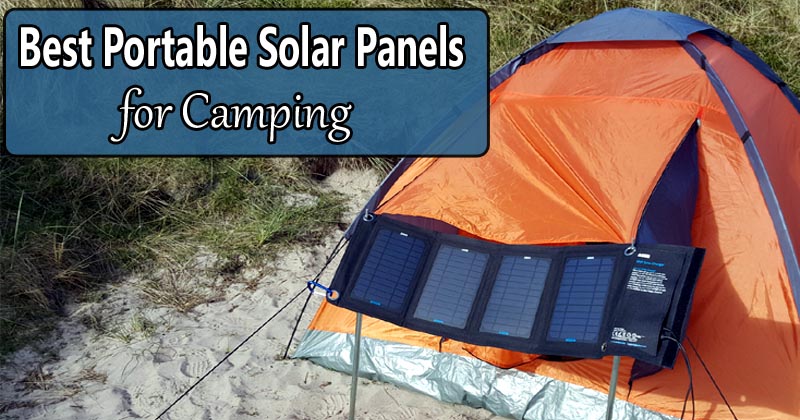
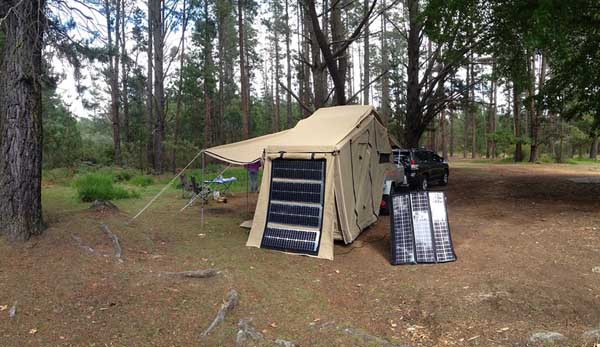

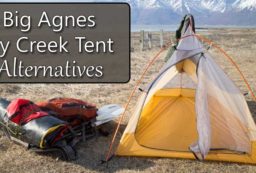

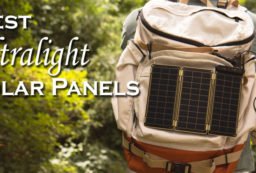







Post your comments